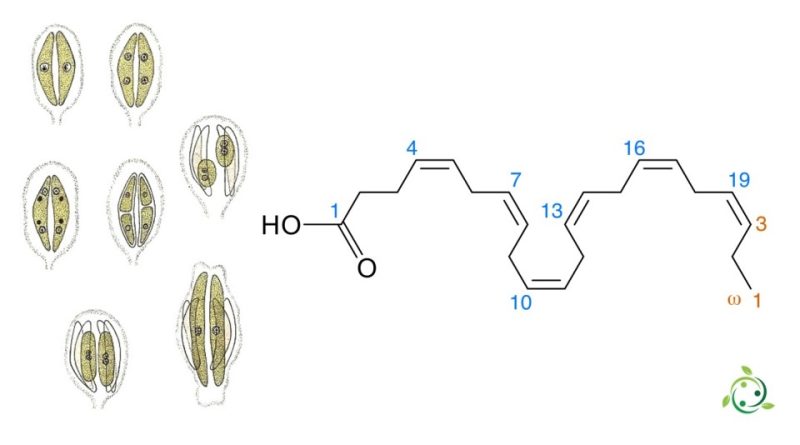Docosahexaenoic acid
Docosahexaenoic acid
Docosahexaenoic acid, which in the official IUPAC nomenclature is known by the term: docosa-4Z,7Z,10Z,13Z,16Z,19Z-hexaenoic acid, is an omega-3 fatty acid, also known as DHA (acronym of the English docosahexaenoic acid).
Docosahexaenoic acid is also known by the name of cervonic acid and has a brute or molecular formula: C22H32O2.
DHA is a primary structural component of the human brain, cerebral cortex, skin and retina.
From a chemical point of view it is a carboxylic acid with a chain of 22 carbon atoms and 6 double bonds in the cis position; the first double bond is found on the third carbon atom from the omega terminal position of the methyl group.
Docosahexaenoic acid occurs naturally mainly in marine organisms, including some species of algae. However, the concentration of DHA in plants is generally very low compared to marine organisms.
In particular, marine plants known to contain significant amounts of docosahexaenoic acid are microscopic marine algae, such as algae of the Haptophyta class (for example, coccolithophore algae and cryptophyte algae), algae of the Bacillariophyceae (diatoms) and algae of Chlorophyceae (green algae).
It is important to note that although these marine plants may contain DHA, the primary source of DHA for animals, including humans, is the intake of marine organisms that have accumulated DHA through the food chain.
For example, fish such as salmon, sardines, tuna and herring are known to be rich in docosahexaenoic acid, thanks to the intake of marine algae or other organisms that contain it.
Docosahexaenoic acid becomes more and more concentrated in organisms as it moves up the food chain. DHA is also commercially produced from microalgae, Crypthecodinium cohnii which is a microorganism of the genus Schizochytrium. The DHA produced using microalgae is therefore of plant origin.
Some animals with access to the sea synthesize DHA very little through metabolism, but mainly take it in the diet. However, in herbivores and carnivores that don’t eat fish, DHA is produced internally from α-linolenic acid, an omega-3 fatty acid that can be found in some plants, such as flaxseed and also in animals that eat plants. The conversion of α-linolenic acid (ALA) into DHA requires several steps where elongase and desaturase enzymes act in sequence through the formation of eicosapentaenoic acid. The process is poorly efficient and DHA can be considered an essential fatty acid.
Furthermore, docosahexaenoic acid is the main fatty acid of the phospholipids contained in the brain and retina and affects the quality of sperm. Research is ongoing to evaluate the potential role or benefits linked to DHA in various pathologies, and cardiovascular diseases. Some research suggests that low levels of DHA appear to be associated with Alzheimer’s disease.
Warning: The information provided is not medical advice and may not be accurate. The contents are for illustrative purposes only and do not replace medical advice.

